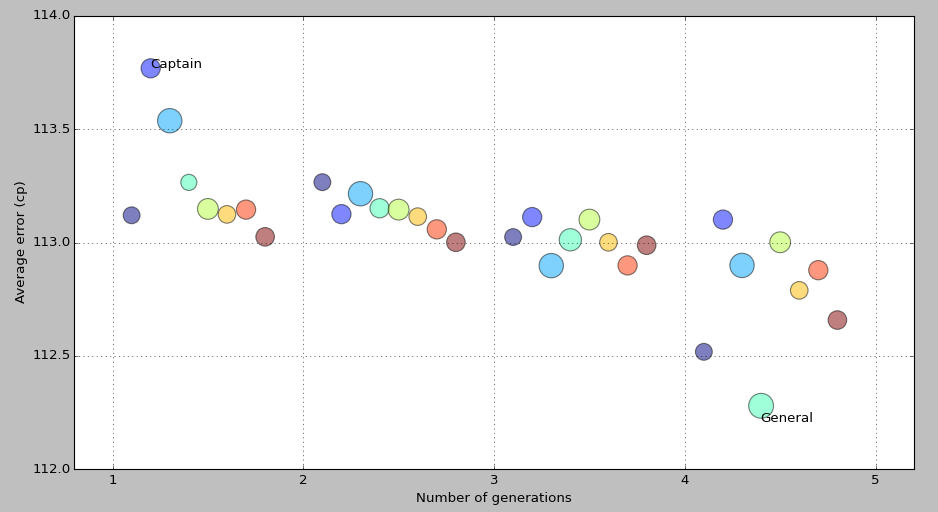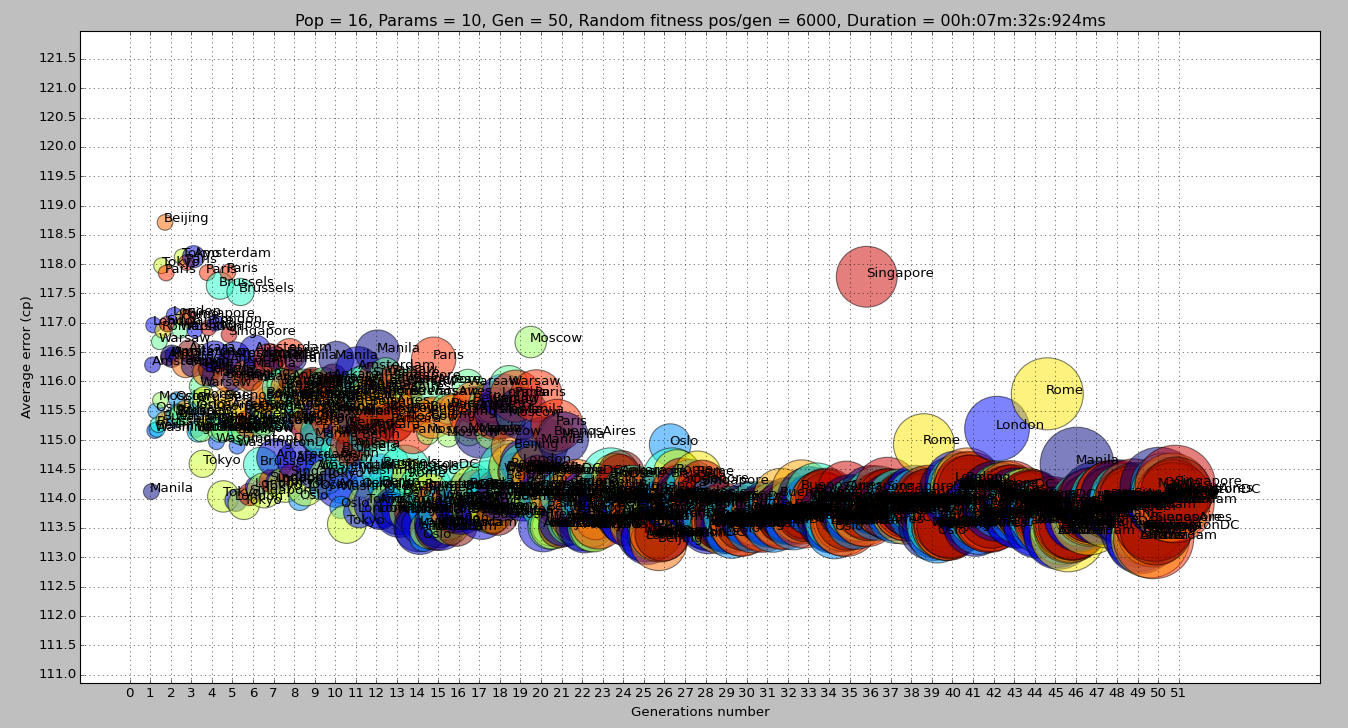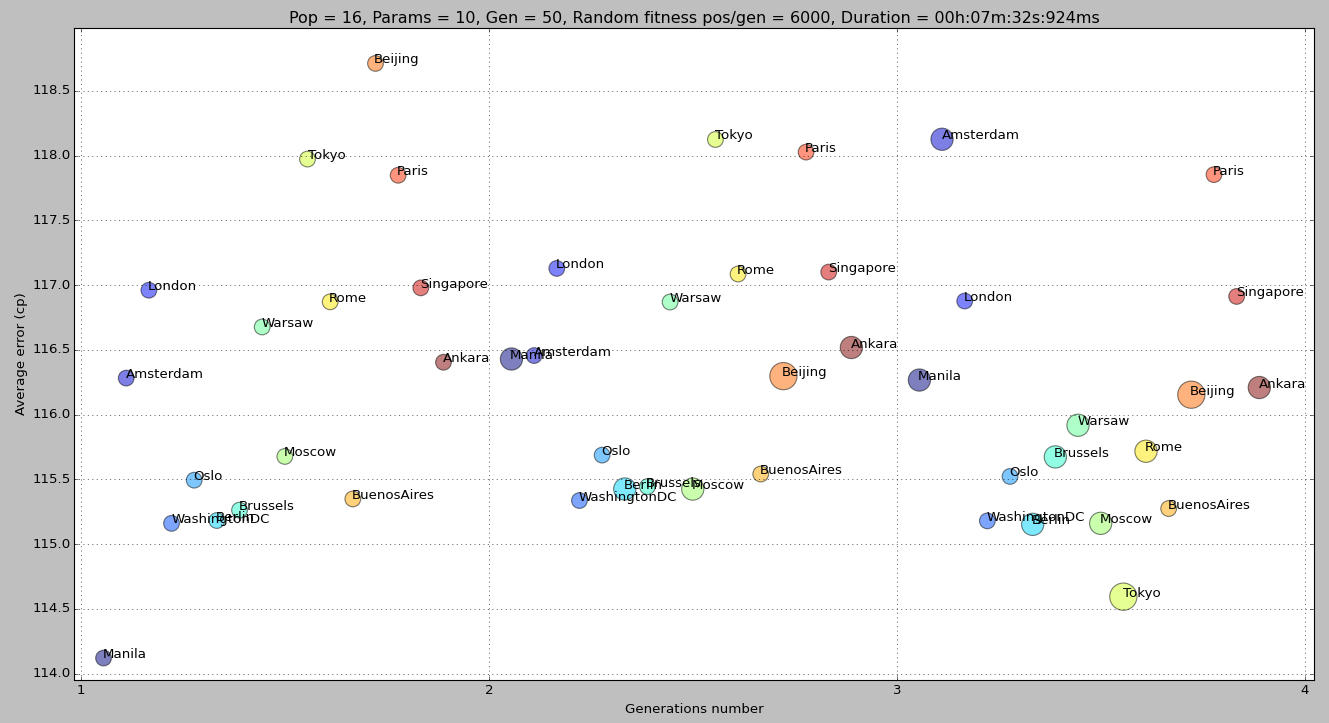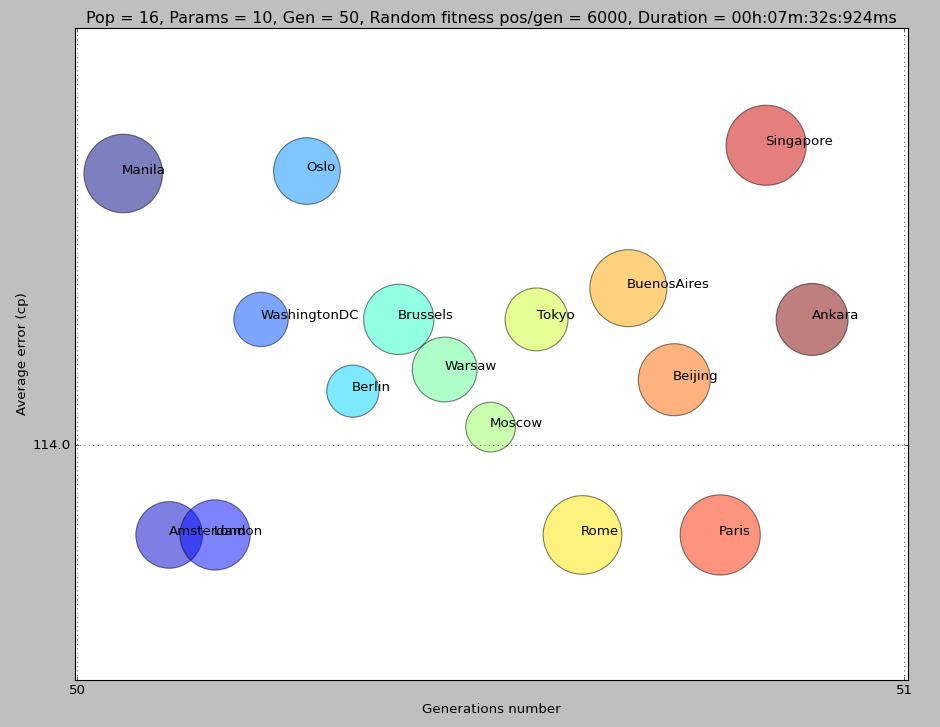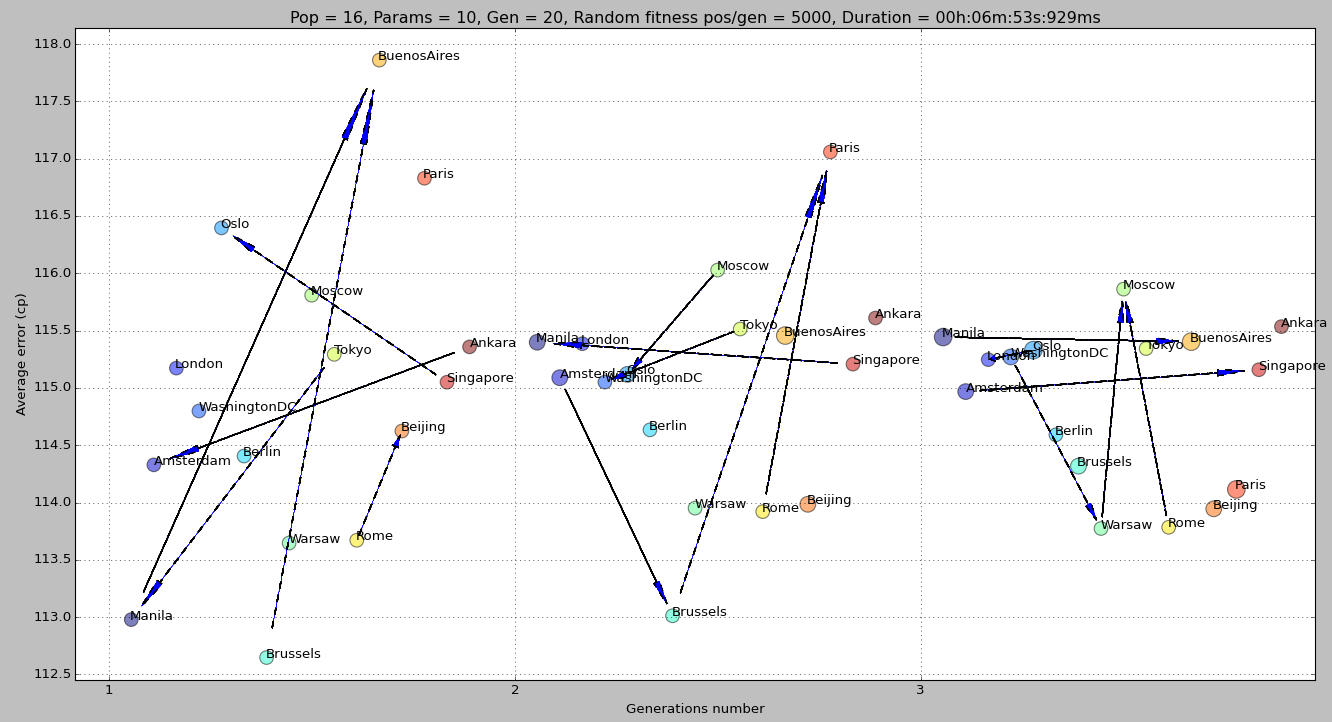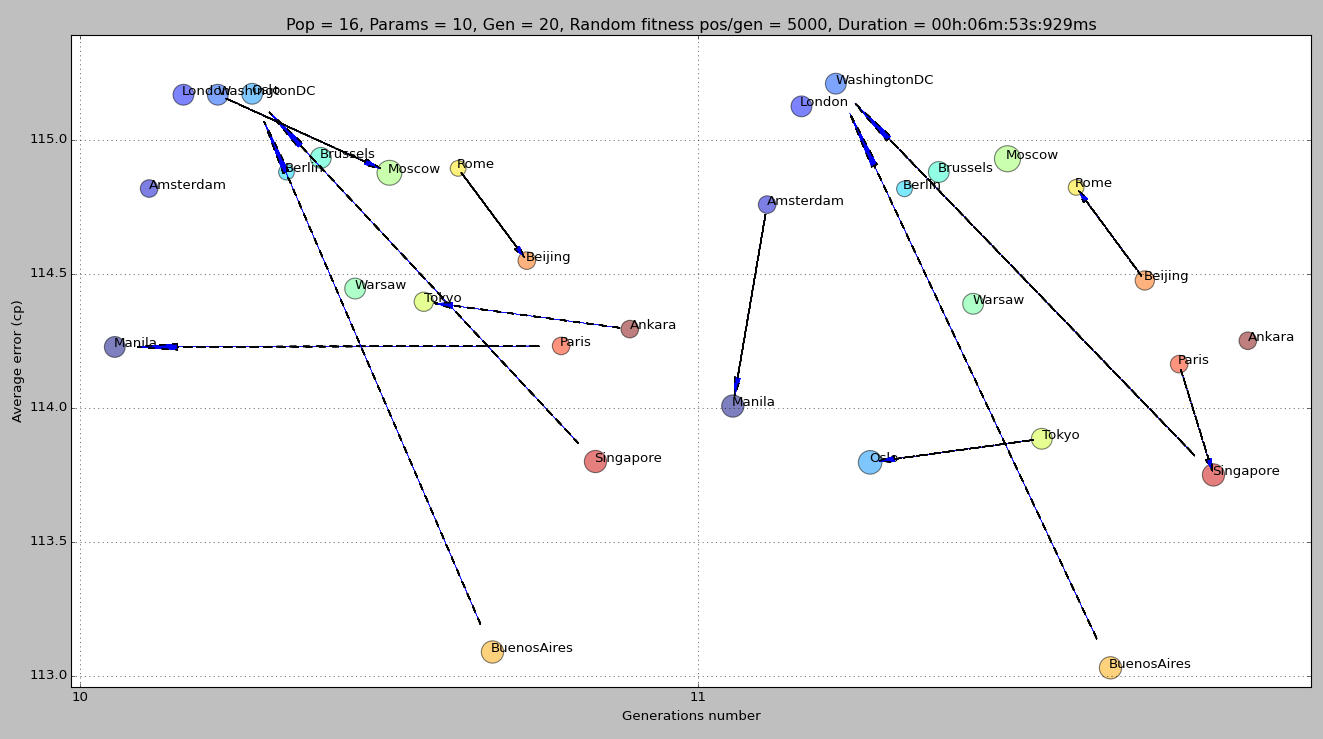Tried to improve the plots. Now with more engines, params and a new method of introducing training pos. Instead of a fixed training sets given per generation I varied it by randomizing. Here is the initial plot, Manila uses the default value of Deuterium, the other individuals are using randomized parameter values, as their first values. Bigger area of circles suggests the individual received more crossovers.
Here is the plot after 1st, 2nd and 3rd generations.
Here we can see Manila was first after the 1st gen. It is using the default values. Last was Beijing., In the 2nd gen Beijing has improved a lot after crossovers from Manila and Washington. (I wonder what will happen now in South China Sea)
. The size of Beijing has increased twice because it received genes from Manila and Washington. Manila also has increased in size and is struggling to reduce the average error. Washington does not change its size, meaning it does not received new genes from other individual when crossover process was done after first generation. But look its average error, it is also showing difficulties, this is because the training sets in the second generation is different from the training sets given in the first generation. It seems there are some individuals that also experienced difficulties in the 2nd gen, Tokyo, London and Paris are visible.
And this is the plot for last generation or 50. Though different sets of training positions are given, the population were able to reduce the average error.
Here are the parameters involved, found in params_to_tune.txt file.
Other info.
Code: Select all
Population : 16
Target generations : 50
Fitness positions : 6000
Base engine : Deuterium v2015.1.35.239 64bit POP
Parameters or genes considered to optimize fitness of individuals:
0, OffensivePercent
1, DefensivePercent
2, KnightValueMg
3, KnightValueEg
4, BishopValueMg
5, BishopValueEg
6, RookValueMg
7, RookValueEg
8, QueenValueMg
9, QueenValueEg
Chromosome:
['OffensivePercent', 'DefensivePercent', 'KnightValueMg', 'KnightValueEg', 'BishopValueMg', 'BishopValueEg', 'RookValueMg', 'RookValueEg', 'QueenValueMg', 'QueenValueEg']
History of top performers per generation:
generation 1, name Manila, par [100, 100, 325, 315, 328, 327, 504, 498, 996, 999], aveErrCp 114.12030
generation 2, name WashingtonDC, par [177, 110, 335, 313, 344, 323, 525, 514, 1177, 1034], aveErrCp 115.33674
generation 3, name Tokyo, par [104, 127, 335, 312, 333, 311, 484, 527, 1028, 1171], aveErrCp 114.59438
generation 4, name Tokyo, par [104, 127, 335, 315, 336, 348, 504, 526, 1169, 988], aveErrCp 114.03829
generation 5, name Tokyo, par [104, 127, 335, 315, 336, 348, 504, 526, 1169, 988], aveErrCp 113.91199
generation 6, name Tokyo, par [104, 127, 335, 315, 336, 348, 504, 526, 1169, 988], aveErrCp 114.14157
generation 7, name Tokyo, par [104, 127, 335, 315, 336, 348, 504, 526, 1169, 988], aveErrCp 114.23751
generation 8, name Oslo, par [104, 127, 335, 315, 336, 348, 504, 526, 967, 1140], aveErrCp 113.98722
generation 9, name Oslo, par [104, 127, 335, 315, 336, 348, 504, 526, 967, 1140], aveErrCp 114.17203
generation 10, name Tokyo, par [107, 111, 335, 307, 336, 348, 504, 526, 1169, 988], aveErrCp 113.56593
generation 11, name London, par [107, 111, 335, 315, 336, 348, 504, 526, 967, 1140], aveErrCp 113.76947
generation 12, name London, par [107, 111, 335, 312, 333, 348, 504, 526, 967, 1140], aveErrCp 113.77239
generation 13, name Tokyo, par [107, 111, 335, 307, 336, 348, 504, 526, 1169, 988], aveErrCp 113.76378
generation 14, name Oslo, par [107, 111, 335, 313, 336, 348, 504, 526, 967, 1140], aveErrCp 113.32818
generation 15, name Tokyo, par [107, 111, 335, 307, 336, 348, 504, 526, 1169, 988], aveErrCp 113.54158
generation 16, name BuenosAires, par [107, 111, 335, 307, 336, 348, 504, 526, 1044, 1067], aveErrCp 113.75125
generation 17, name BuenosAires, par [107, 111, 335, 307, 336, 348, 504, 526, 1044, 1067], aveErrCp 113.66713
generation 18, name BuenosAires, par [107, 111, 335, 307, 336, 348, 504, 526, 1044, 1067], aveErrCp 113.98427
generation 19, name Tokyo, par [107, 111, 335, 307, 336, 348, 504, 526, 1169, 988], aveErrCp 114.04292
generation 20, name Amsterdam, par [107, 111, 335, 307, 336, 348, 504, 526, 1169, 988], aveErrCp 113.51611
generation 21, name Tokyo, par [107, 111, 335, 315, 336, 348, 504, 528, 1177, 1017], aveErrCp 113.60590
generation 22, name Tokyo, par [107, 111, 335, 315, 336, 348, 504, 528, 1177, 1017], aveErrCp 113.49311
generation 23, name Beijing, par [107, 111, 335, 315, 336, 348, 504, 528, 1177, 993], aveErrCp 113.87451
generation 24, name Beijing, par [107, 111, 335, 315, 336, 348, 504, 528, 1177, 993], aveErrCp 113.57404
generation 25, name Beijing, par [107, 111, 335, 315, 336, 348, 504, 528, 1177, 993], aveErrCp 113.25582
generation 26, name Beijing, par [107, 111, 335, 315, 336, 348, 504, 528, 1177, 993], aveErrCp 113.87818
generation 27, name Beijing, par [107, 111, 335, 315, 336, 348, 504, 528, 1177, 993], aveErrCp 113.85483
generation 28, name Amsterdam, par [107, 111, 335, 307, 336, 348, 504, 526, 1169, 988], aveErrCp 113.52490
generation 29, name Oslo, par [107, 111, 335, 307, 336, 348, 504, 526, 986, 1096], aveErrCp 113.42669
generation 30, name Oslo, par [107, 111, 335, 307, 336, 348, 504, 526, 986, 1096], aveErrCp 113.54144
generation 31, name Oslo, par [107, 111, 335, 307, 336, 348, 504, 526, 986, 1096], aveErrCp 113.56912
generation 32, name Oslo, par [107, 111, 335, 307, 336, 348, 504, 526, 986, 1096], aveErrCp 113.61096
generation 33, name Oslo, par [107, 111, 335, 307, 336, 348, 504, 526, 986, 1096], aveErrCp 113.83537
generation 34, name Oslo, par [107, 111, 335, 307, 336, 348, 504, 526, 986, 1096], aveErrCp 113.45757
generation 35, name Oslo, par [107, 111, 335, 307, 336, 348, 504, 526, 986, 1096], aveErrCp 113.63644
generation 36, name Oslo, par [107, 111, 335, 307, 336, 348, 504, 526, 986, 1096], aveErrCp 113.79182
generation 37, name Oslo, par [107, 111, 335, 307, 336, 348, 504, 526, 986, 1096], aveErrCp 113.73589
generation 38, name Oslo, par [107, 111, 335, 307, 336, 348, 504, 526, 986, 1096], aveErrCp 113.76826
generation 39, name Oslo, par [107, 111, 335, 307, 336, 348, 504, 526, 986, 1096], aveErrCp 113.40456
generation 40, name Oslo, par [107, 111, 335, 307, 336, 348, 504, 526, 986, 1096], aveErrCp 114.01088
generation 41, name Oslo, par [107, 111, 335, 307, 336, 348, 504, 526, 986, 1096], aveErrCp 113.56913
generation 42, name Oslo, par [107, 111, 335, 307, 336, 348, 504, 526, 986, 1096], aveErrCp 113.84524
generation 43, name Oslo, par [107, 111, 335, 307, 336, 348, 504, 526, 986, 1096], aveErrCp 113.73708
generation 44, name Oslo, par [107, 111, 335, 307, 336, 348, 504, 526, 986, 1096], aveErrCp 113.58399
generation 45, name Oslo, par [107, 111, 335, 307, 336, 348, 504, 526, 986, 1096], aveErrCp 113.39519
generation 46, name Oslo, par [107, 111, 335, 307, 336, 348, 504, 526, 986, 1096], aveErrCp 113.69475
generation 47, name Amsterdam, par [107, 111, 335, 307, 336, 348, 504, 526, 986, 1096], aveErrCp 113.81290
generation 48, name Amsterdam, par [107, 111, 335, 307, 336, 348, 504, 526, 986, 1096], aveErrCp 113.83456
generation 49, name Amsterdam, par [107, 111, 335, 307, 336, 348, 504, 526, 986, 1096], aveErrCp 113.31809
generation 50, name Amsterdam, par [107, 111, 335, 307, 336, 348, 504, 526, 986, 1096], aveErrCp 113.93207
Top 5 performing individuals at given generation:
generation 25, name Beijing, par [107, 111, 335, 315, 336, 348, 504, 528, 1177, 993], aveErrCp 113.25582
generation 49, name Amsterdam, par [107, 111, 335, 307, 336, 348, 504, 526, 986, 1096], aveErrCp 113.31809
generation 14, name Oslo, par [107, 111, 335, 313, 336, 348, 504, 526, 967, 1140], aveErrCp 113.32818
generation 45, name Oslo, par [107, 111, 335, 307, 336, 348, 504, 526, 986, 1096], aveErrCp 113.39519
generation 39, name Oslo, par [107, 111, 335, 307, 336, 348, 504, 526, 986, 1096], aveErrCp 113.40456
Test duration : 00h:07m:32s:924ms

